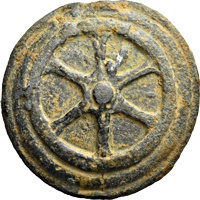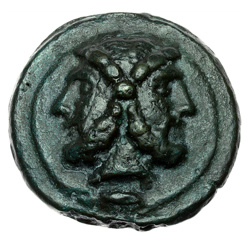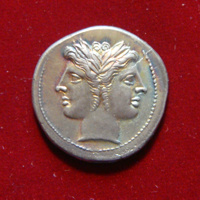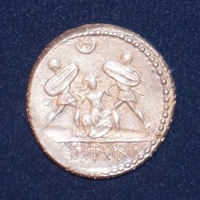Roman Republican Coins
289 BC - 30 BC
The Normal Republican Period 289 - 100 BC
 Aes Grave: Roma Head rev: Wheel of 6 spokes Cast bronze As dia ~-- mm, wt ~ 276.94 g 269 - 240 B.C.E. Gorny & Mosch auction 257, 2018, lot# 632 Gorny & Mosch auction 215, 2013, lot# 3 |
one of the earlier Aes Grave types. |
"As for our case, that is the denarius with the wheel symbol on the R/, for the sake of
completeness we must remember that this appears in the coinage of Etruria, Luceria and
Massalia, but it is also known as the wheel is a purely Roman symbol related to the military
sphere, the road system and roads: with caution we could assume the destination of this
denarius to exceptional expenses for the construction of one or more viae publicae between
the end of the third and the first half of the second century BC." -- from bertolamifineart Of course this isn't a denarius but the research behind the Roman wheel design is pertinent. |
 Aes Grave: Janus Head /Galley Prow semi-libral Cast bronze As dia ~63 mm, wt ~ 258 g 225 - 217 B.C.E. Artemide Aste auction 37, July 11-12, 2012, lot# 102 |
This is a large leaded bronze coin which was CAST by the Roman Republic just before the 2nd
Punic War. They are known as Aes Grave or Heavy Bronze. A Roman pound was originally 273 g and
this piece represents a reduction in weight from that. This is the Vecchi (Italian Cast Coinage,
1979, Bradbury K. Thurlow & Italo G. Vecchi, Hardcover) type 51, Janus Head / Prow of Galley with
horizontal bar (mark of denomination) obverse. |
-------------- |

Silver Quadrigatus Janus Head ca 225 B.C. (Numismatic Fine Arts, auction XX, lot# 5, 1989 |
wt = 6.685 g These were struck to the Greek standard of a didrachm before the advent of the denarius. | |
 Tarpia buried by shields |
||
 a denarius serratus |
There is an extremely good article about the Serratii also called the Denarius Serratus,
written by Andrea Pancotti and Patrizia Calabria of Bertolami. |